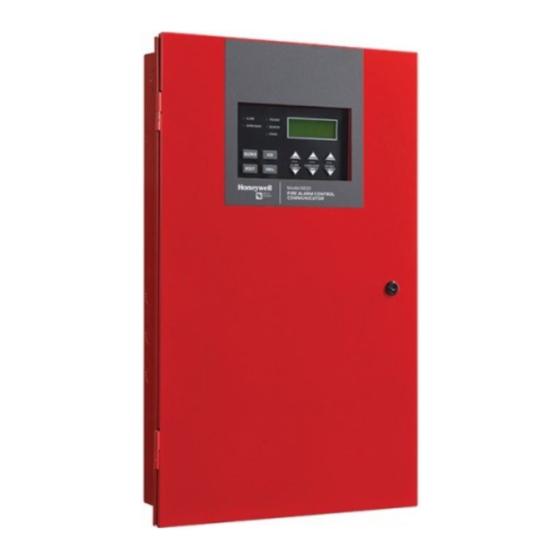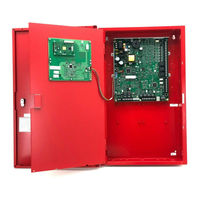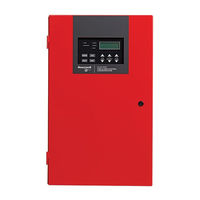
Honeywell 6820 Manuals
Manuals and User Guides for Honeywell 6820. We have 3 Honeywell 6820 manuals available for free PDF download: Installation And Optimization Manual, Installation And Operation Manual, Manual
Honeywell 6820 Installation And Optimization Manual (250 pages)
Addressable Fire System
Emergency Voice System
Table of Contents
-
Section 1
14 -
Introduction
14 -
Section 2
18 -
-
Section 3
23 -
-
Inventory23
-
-
Section 4
35 -
-
SBUS Wiring39
-
-
Section 5
80 -
-
Section 6
90 -
-
Section 7
102 -
-
Section 8
112 -
-
Mapping Overview114
-
Event Mapping117
-
Section 9
132 -
Programming
132-
Modules133
-
Edit Modules133
-
Naming Modules133
-
Adding a Module134
-
View Module List134
-
-
Zone135
-
Edit Zone135
-
Edit Zone Name135
-
-
View Zone Points137
-
-
Group137
-
Edit Group137
-
Edit Group Name138
-
-
-
Point141
-
System Options149
-
-
Auto Test Time149
-
Phone Lines150
-
Edit Ethernet152
-
Alarmnet Timers152
-
Phone Line Gains153
-
-
Time Options153
-
Edit Banner156
-
SLC Family156
-
-
Restore Defaults157
-
VCM Maintenance157
-
Section 10
158 -
System Operation
158-
-
LCD Display159
-
Banner159
-
-
Menu System160
-
Using the Menus161
-
Basic Operation161
-
Reset Alarms164
-
Event Priority167
-
System Control167
-
System Override167
-
Event Priority168
-
Priority Rules169
-
-
Function Keys177
-
Section 11
179 -
-
Overview179
-
-
Keys and Leds179
-
EVS Control Key179
-
EVS Control LED179
-
EVS Message Keys180
-
EVS Message Leds180
-
Select Keys180
-
Select Key Leds180
-
-
-
LOC Priority181
-
LOC Lockout181
-
-
Manual EVS182
-
Microphone Mode183
-
Message Mode183
-
Custom EVS Event183
-
EVS Reset184
-
-
EVS Super User184
-
LOC Programming186
-
Adding an LOC186
-
Editing an LOC186
-
LOC Priority187
-
LOC Association187
-
-
-
Advertisement
Honeywell 6820 Installation And Operation Manual (216 pages)
Addressable Fire System, Emergency Voice System
Brand: Honeywell
|
Category: Fire Alarms
|
Size: 5.6 MB
Table of Contents
-
Inventory20
-
SBUS Wiring35
-
1: Panels72
-
Edit Name84
-
1: Input Points100
-
2: Output Points100
-
Mapping Overview101
-
3: Event Mapping103
-
Modules118
-
1: Edit Modules118
-
Naming Modules118
-
Zone119
-
1: Edit Zone120
-
Edit Zone Name120
-
Group122
-
1: Edit Group122
-
Edit Group Name122
-
Point124
-
System Options131
-
Auto Test Time131
-
Phone Lines131
-
Edit Ethernet133
-
Alarmnet Timers133
-
Phone Line Gains133
-
2: Time Options134
-
Water Flow Delay134
-
Alarm Verify134
-
AC Report Delay134
-
5: Edit Banner135
-
6: SLC Family136
-
Restore Defaults137
-
VCM Maintenance137
-
1: LCD Display139
-
2: Banner139
-
Menu System140
-
Basic Operation140
-
9: Reset Alarms142
-
Event Priority145
-
Function Keys152
-
Overview154
-
1: Keys and Leds154
-
EVS Control Key154
-
EVS Control LED154
-
EVS Message Keys154
-
EVS Message Leds154
-
Select Keys154
-
Select Key Leds155
-
LOC Priority155
-
LOC Lockout155
-
3: Manual EVS156
-
5: Message Mode156
-
10: EVS Reset157
-
EVS Super User157
-
LOC Programming158
-
1: Adding an LOC159
-
LOC Priority159
-
LOC Association159
-
3: Fire Page159
-
5: Paging160
-
Troubleshooting178
Honeywell 6820 Manual (170 pages)
Addressable Fire Alarm Conrol Panel
Brand: Honeywell
|
Category: Control Panel
|
Size: 2.96 MB
Table of Contents
-
Inventory17
-
SBUS Wiring31
-
1: Panels61
-
4: Wiring64
-
Modules90
-
Zone92
-
1: Edit Zone92
-
Group94
-
Point95
-
System Options104
-
2: Time Options106
-
5: Edit Banner108
-
6: SLC Family108
-
Restore Defaults109
-
Voice Options109
-
1: LCD Display111
-
2: Banner112
-
Menu System112
-
Basic Operation114
-
10: Reset Alarms116
-
Event Priority119
-
Function Keys125
-
Overview127
-
1: Keys and Leds127
-
3: Manual EVS128
-
4: Fire129
-
5: Message Mode129
-
10: EVS Reset131
-
EVS Super User131
-
LOC Programming132
-
1: Adding an LOC132
-
3: Fire Page133
-
5: Paging133
-
Troubleshooting149
-
Event History150
Advertisement


